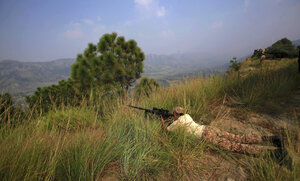The only path for India, Pakistan
A truce in Kashmir and an agreement to discuss “core” issues between the two rivals makes sense in light of bigger concerns and opportunities.

Pakistan soldiers take positions in 2016 at Bagsar, a forward post on the Line of Control, that divides Kashmir between Pakistan and India.
AP
In the digital universe, the young netizens in India and Pakistan have no problem sharing across a tense and often violent border between the two rival states. The latest example is an Instagram video of a Pakistani teenage influencer suggesting people need to party (“pawri”). It went viral in India, sparking joyous spinoffs. Young people also revel in each country’s movies and cricket teams. This neighborly culture is just one of many backdrops that help explain why India and Pakistan have restored a 2003 truce in disputed Kashmir. More importantly, they agreed to address each other’s “core issues.”
Perhaps the biggest backdrop to the agreement is that the two countries, both nuclear-armed, can no longer afford military conflict. They have fought three wars and had frequent flare-ups since they each gained independence from Britain in 1947. Pakistan’s economy is now on the ropes, requiring massive foreign loans, while India has its hands full with a dangerous dispute with China over Himalayan territory and a domestic revolt by farmers.
The very old turf war in Kashmir, long exploited by extremists on both sides, seems minor in light of modern concerns and opportunities. “Dialogue is the only way forward if both countries want to stop the unending cycle of violence & bloodshed across the borders,” tweeted a prominent Kashmiri politician, Mehbooba Mufti.
For his part, Pakistan’s prime minister, former famed cricketer Imran Khan, agrees that talks are the best path. As for a reason, he said, “The only way the subcontinent can tackle poverty is by improving trade relations.” Few goods travel between India and Pakistan compared with trade between other countries.
His chief national security aide, Moeed Yusuf, claims the agreement is a “very solid and positive” development that will allow “more roads to open.” The two countries, one largely Muslim and the other largely Hindu, have many ways to overcome their deep suspicions of each other. A long-lasting truce in the 460-mile-long unofficial frontier in Kashmir would be just a start. Any reconciliation would need to extend into military and trade areas. They would also have to deal with their diverging narratives of their shared past, something that drives nationalists in each country.
A peace dialogue needs to show quickly that diplomacy can produce results faster than continued violence around Kashmir. Many young people on both sides are already digitally linked. They see more what’s in common than what is not. That would be worth celebrating.

